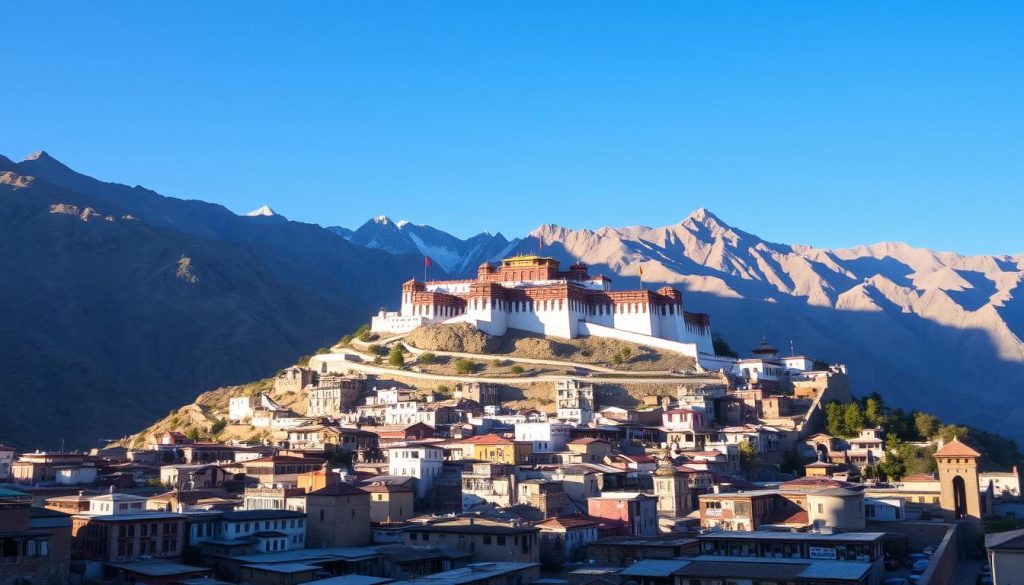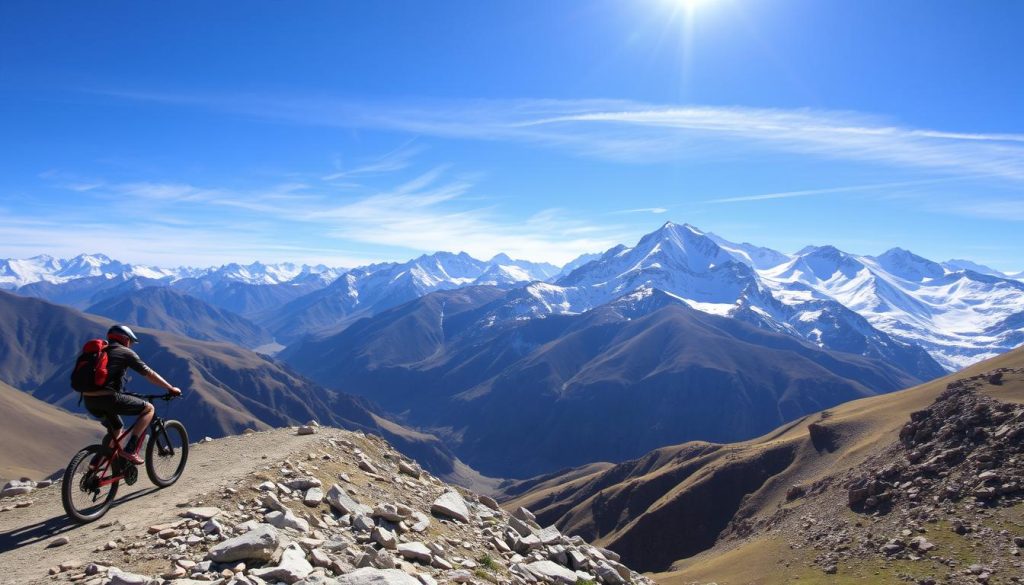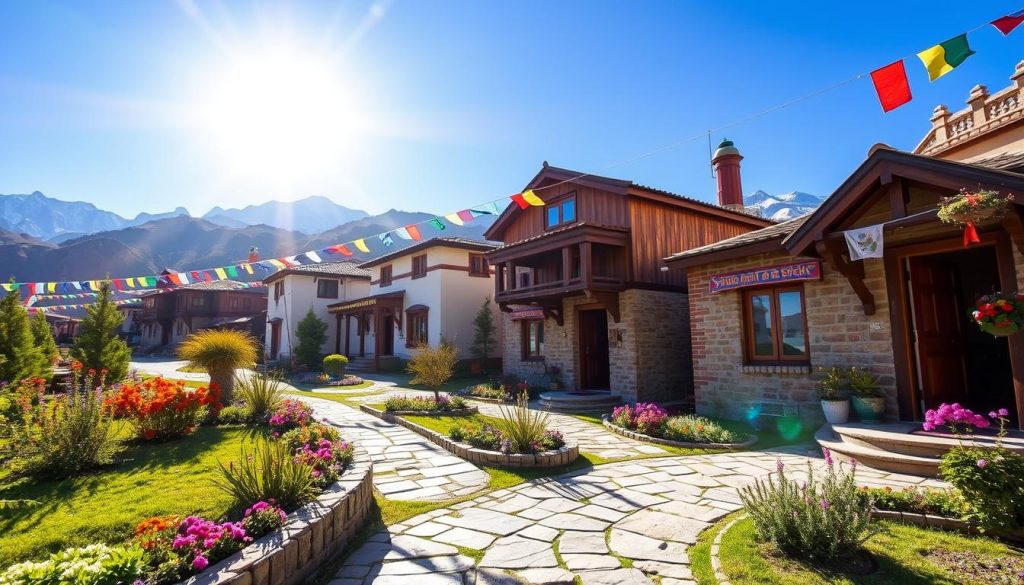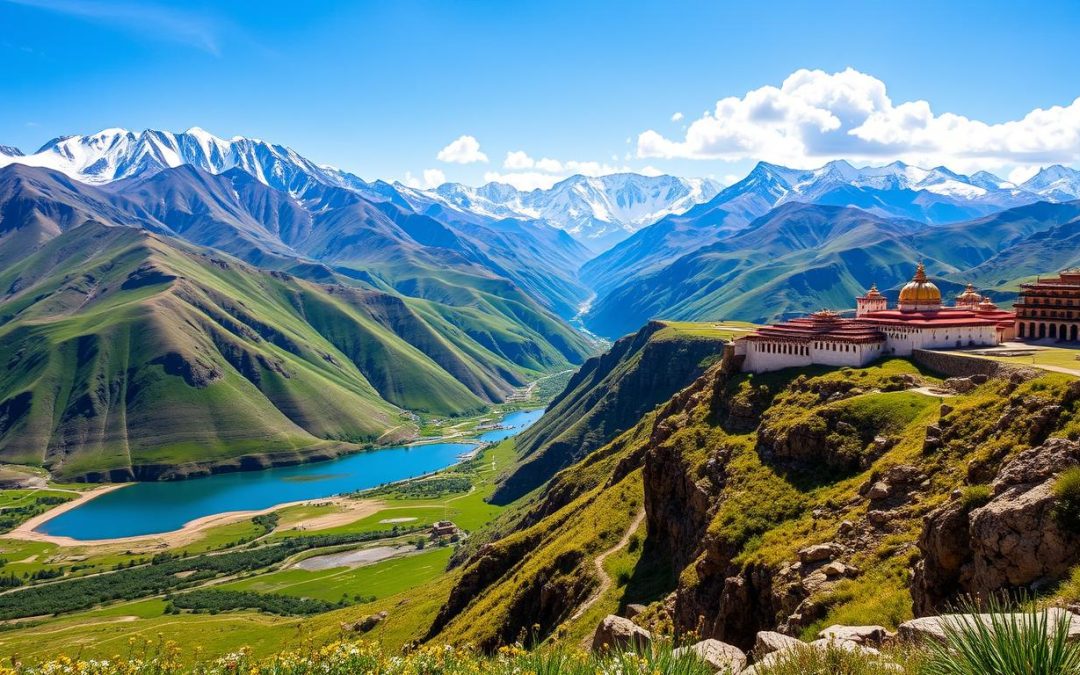Ever dreamed of a place that feels like another world but is rich in culture? Welcome to Leh, Ladakh (UT). It’s a high-altitude desert that offers adventure, spiritual growth, and stunning beauty.
Ladakh tourism takes you on an amazing journey. It’s in northern India and turns your trip into an epic adventure. You’ll see landscapes that change how you see travel.
Leh has ancient Buddhist monasteries on cliffs and clear lakes that mirror the sky. It’s perfect for anyone who loves adventure, culture, or nature. Ladakh gives you memories that will stay with you forever.
Key Takeaways
- Discover unique high-altitude landscapes
- Experience rich Buddhist cultural heritage
- Engage in diverse adventure activities
- Explore ancient monasteries and historical sites
- Enjoy pristine natural environments
- Immerse in local Ladakhi traditions
Understanding Ladakh: The Land of High Passes
Ladakh is in the northernmost part of India. It has a unique landscape that attracts adventurers. The region is mostly desert, with rugged mountains and stunning beauty.
Exploring Ladakh means getting to know its geography and culture. Leh, at 11,500 feet, is one of the highest cities in the world. This makes it a special place for travelers.
Geography and Climate
Ladakh’s terrain is extreme, with high mountain passes like Khardungla Pass at 17,572 feet. Winters can be very cold, dropping to -40 degrees Celsius. Yet, this harsh climate is also beautiful.
- Average elevation: 11,500 feet
- Highest motorable pass: Umling La at 19,022 feet
- Typical landscape: High desert with minimal precipitation
Cultural Heritage
Ladakh’s culture is rich in Tibetan Buddhist traditions. Places like Hemis Monastery show the spiritual side of the region. They offer insights into local customs and beliefs.
“Ladakh is not just a destination, it’s an experience that transforms your perception of natural beauty and human resilience.” – Local Travel Guide
Best Time to Visit
Choosing the right time to visit Ladakh is important. The best months are June to September. During this time, the weather is good and the passes are clear.
| Season | Temperature Range | Travel Suitability |
|---|---|---|
| Summer (June-September) | 15°C to 25°C | Ideal for tourism |
| Winter (October-May) | -10°C to 10°C | Challenging for travel |
Pro Tip: It’s wise to acclimatize for 24-48 hours. This helps avoid altitude sickness and makes your trip more enjoyable.
Essential Travel Planning Guide
Planning your Leh-Ladakh adventure needs careful thought. You’ll need to plan your journey through this stunning mountain area well. This includes making travel arrangements and thinking strategically.
- Altitude Acclimatization: Spend at least 24-48 hours in Leh to adapt to high-altitude conditions
- Physical Fitness: Prepare with cardiovascular and strength training before your trip
- Permit Requirements: Obtain necessary Inner Line Permits for restricted areas
- Medical Preparations: Carry altitude sickness medication and consult your doctor
Trekking in Leh-Ladakh has many package options for different tastes:
| Package Duration | Attractions Covered | Recommended For |
|---|---|---|
| 5 Days / 4 Nights | 13 attractions | First-time travelers |
| 6 Days / 5 Nights | 15 attractions | Adventure enthusiasts |
| 8 Days / 7 Nights | 14 attractions | Comprehensive exploration |
“Preparation is the key to an unforgettable Ladakh adventure” – Local Trekking Guide
Here are some must-pack items for your Leh-Ladakh trek:
- Thermal layers
- Waterproof hiking gear
- High-altitude sunscreen
- Water purification tablets
- Sturdy trekking boots
The best time for trekking in Leh-Ladakh is from May to September. This period offers great weather and easy access to mountain paths. Also, book your stay and travel early to make your trip smooth and memorable.
Exploring Ancient Buddhist Monasteries
Ladakh’s monasteries, known as gompas, are architectural wonders. They give us a deep look into the region’s spiritual past. These ancient sites are not just buildings but living museums of Ladakhi culture, set against the dramatic mountains.
Visiting the monasteries in Ladakh is a journey through time. You’ll see spiritual landmarks that have seen centuries of Buddhist tradition. Each monastery has its own story of faith, art, and preserving culture.
Hemis Monastery: A Cultural Jewel
Hemis Monastery was founded in the 1630s. It’s the largest and most important monastery in central Ladakh. The monastery is famous for the Hemis Festival in June or July, drawing visitors worldwide.
The monastery’s highlight is its three-storey thangka. It’s unveiled every 12 years, with the last display in 2016.
- Largest monastery in central Ladakh
- Founded in the 1630s
- Home to rare Buddhist artifacts
- Hosts an annual festival in summer
Thiksey Monastery: The Potala of Ladakh
Thiksey Monastery is like the famous Potala Palace in Lhasa. It’s a stunning structure that cascades down a hillside. Its tiered design creates a breathtaking view against Ladakh’s rugged terrain.
The monastery is known for its intricate Buddhist art. It hosts a festival in October or November, following the Tibetan lunar calendar.
Diskit Monastery: Guardian of Nubra Valley
Diskit Monastery is 120 km from Leh and the oldest and largest gompa in the Nubra Valley. It offers stunning views and has a massive Buddha statue. The monastery is the spiritual heart of this remote Himalayan region.
“In Ladakh, every monastery is a window into a thousand years of spiritual wisdom and cultural resilience.”
| Monastery | Location | Founded | Unique Feature |
|---|---|---|---|
| Hemis | Central Ladakh | 1630s | Largest monastery, rare thangka |
| Thiksey | Near Leh | 15th Century | Tiered architecture |
| Diskit | Nubra Valley | Early Historical Period | Massive Buddha statue |
Exploring Ladakh’s monasteries is a journey through time. Each site offers a unique look into Buddhist culture and the rich history of this remarkable region.
Leh Palace and Old Town Discovery

The Leh Palace sits high above the lively city, a historic landmark. Built in the 17th century, it has nine stories and mirrors the grand Potala Palace of Tibet. It offers a peek into Ladakh’s royal history.
Exploring Leh, the palace shows off Ladakhi architecture. Its stone walls and wooden balconies tell tales of the past. They invite you to imagine the royal life that once was.
“A journey through Leh Palace is a journey through the soul of Ladakhi history” – Local Historian
Key Highlights of Leh Palace
- Panoramic views of the surrounding Himalayan landscape
- Museum showcasing royal artifacts and traditional costumes
- Stunning architectural design reminiscent of Tibetan styles
- Restored sections offering insights into historical construction techniques
The Old Town is just as fascinating. Its narrow streets, traditional houses, and markets feel like stepping back in time. You’ll find hidden temples, meet local artisans, and take amazing photos.
| Palace Feature | Details |
|---|---|
| Construction Period | 17th Century |
| Total Floors | 9 Levels |
| Current Status | Partially Restored Museum |
| Architectural Inspiration | Tibetan Palace Design |
Pro Tip: Visit early morning or late afternoon for the best light and fewer people.
Leh, Ladakh (UT): Best Things to Do – Top Picks
Ladakh is a place of breathtaking adventures. It has stunning landscapes and high-altitude spots. Every traveler will find unforgettable memories here.
Pangong Lake Adventures
Pangong Lake is a natural wonder at 14,250 ft. It’s 150 km from Leh, a 5-hour drive over Changla Pass. The lake’s colors change, making it magical.
- Capture stunning photographs of the changing lake colors
- Enjoy overnight camping experiences
- Witness breathtaking sunrise and sunset views
Nubra Valley Excursions
Nubra Valley is a desert in the Himalayas. You can ride double-humped camels and see Diskit Monastery. It’s a unique experience.
| Destination | Distance from Leh | Unique Feature |
|---|---|---|
| Diskit Monastery | 120 km | Largest monastery in Nubra Valley |
| Hunder Sand Dunes | 130 km | Rare desert landscape in mountains |
Khardung La Pass Experience
Khardung La Pass is a mountain adventure. It’s one of the world’s highest roads at 18,380 ft. The views are incredible.
“The road to Khardung La is not just a journey, but a conquest of nature’s most challenging terrain.” – Ladakhi Traveler’s Guide
These places show Ladakh’s beauty and charm. Whether you want adventure, photos, or spiritual experiences, you’ll find it here. These memories will last forever.
Adventure Activities and Outdoor Experiences
Ladakh is a paradise for those who love adventure and nature. Trekking in Leh-Ladakh offers a unique chance to see stunning landscapes. These landscapes are both challenging and inspiring for adventure lovers.

- Mountain Trekking across breathtaking trails
- River Rafting on Zanskar and Indus rivers
- Mountain Biking through rugged terrains
- Camel Safari in Nubra Valley
- Paragliding with panoramic mountain views
Ladakh is perfect for those who love high-altitude adventures. The Markha Valley Trek and Stok Kangri Expedition are favorites among adventurers.
“Ladakh is not just a destination, it’s an adventure waiting to be experienced.”
| Activity | Average Cost (INR) | Best Season |
|---|---|---|
| River Rafting | 1500-1800 | June-September |
| Camel Safari | 150-5000 | Summer Months |
| Paragliding | 2000-4000 | June-September |
Whether you’re an experienced adventurer or new to exploring, Ladakh has something for everyone. Its diverse terrain promises an unforgettable outdoor experience that will challenge and inspire you.
Local Cuisine and Food Culture
Ladakhi cuisine is a fascinating mix of Tibetan, Central Asian, and local flavors. It’s a culinary adventure in Leh, where every dish shares a story of culture and mountain traditions.
Traditional Ladakhi Dishes
Explore the heart of Ladakhi cuisine with its beloved dishes. The region’s culinary treasures include:
- Thukpa: A hearty noodle soup with vegetables and sometimes meat
- Momos: Steamed dumplings filled with chicken or vegetables
- Skyu: A traditional pasta-like dish made with wheat flour
- Chhutagi: Unique pasta served in a rich broth
Best Local Restaurants
Leh has a diverse culinary scene for all tastes. From authentic Ladakhi eateries to international cuisine, there’s something for everyone.
| Cuisine Type | Price Range | Popular Dishes |
|---|---|---|
| Tibetan | ₹100-250 | Chicken Momos, Thukpa |
| Indian | ₹80-200 | Local Curries, Naan |
| Continental | ₹150-350 | Pasta, Sandwiches |
Food Markets
Local markets in Leh offer a true taste of Ladakhi cuisine. You’ll find fresh produce, local spices, and street food. Desserts are affordable, ranging from ₹50 to ₹100.
“In Ladakh, food is not just sustenance; it’s a celebration of culture and survival in the high mountain landscape.”
Exploring Ladakhi cuisine is a journey through centuries of culinary tradition. It’s as memorable as the stunning landscapes around you.
Sacred Sites and Spiritual Landmarks
Ladakh is more than its famous monasteries. It’s a place filled with sacred energy, calling to those who seek spiritual connection. Leh’s attractions show the deep spiritual roots of the region through ancient Buddhist sites and unique landmarks.

Exploring Ladakh’s spiritual side, you’ll find many remarkable places:
- Shanti Stupa: A white monument from 1991, with stunning views of Leh
- Gurudwara Pathar Sahib: A sacred Sikh shrine, 25 km from Leh
- Magnetic Hill: A place where nature meets spiritual tales
“In Ladakh, every stone tells a story, every landscape whispers a prayer.” – Local Wisdom
These sites are more than just beautiful buildings. Prayer wheels and mani walls are everywhere, showing the deep connection to Buddhism. Visitors can engage with these objects, learning about their cultural and spiritual value.
| Sacred Site | Location | Significance |
|---|---|---|
| Shanti Stupa | Leh | Built in 1991, contains Buddha relics |
| Gurudwara Pathar Sahib | 25 km from Leh | Commemorates Guru Nanak’s journey |
| Magnetic Hill | 27 km from Leh | Creates unique optical illusion |
These sites are not just for looking. They open a door to Ladakhi culture’s spiritual heart. They invite you to find peace and quiet reflection.
Transportation and Getting Around
Exploring Ladakh’s stunning landscapes needs careful planning. Knowing how to get around makes your trip unforgettable.
Road Trip Options
Ladakh offers many road trip adventures. You can pick from exciting routes:
- Manali to Leh route (approximately 2,000 km)
- Srinagar to Leh highway
- Bike expeditions ranging from 5-10 nights
Bike trip packages come in different prices and lengths:
| Trip Type | Price (per person) | Duration |
|---|---|---|
| Leh Sightseeing | ₹4,000 | 2 Nights |
| Manali to Ladakh | ₹35,000 | 10 Nights |
| Leh Ladakh Bike Trip | ₹13,000 | 5 Nights |
Local Transport
Getting around Ladakh involves knowing local transport. Bus services have improved since 2018:
- Bus fares between destinations range from ₹75 to ₹316
- Frequent bus services connect Leh to nearby villages
- Shared taxis provide flexible travel options
“The journey is the destination in Ladakh” – Local Travel Wisdom
Altitude Considerations
Traveling in Ladakh requires managing altitude. The high elevation needs careful acclimatization:
- Khardung La Pass sits at over 18,000 feet
- Travel between destinations can take 4-5 hours
- Gradual ascent is recommended to prevent altitude sickness
Understanding these transport tips ensures a safe, enjoyable Ladakh adventure.
Accommodation Options in Leh
Finding the right place to stay can make your Ladakh trip unforgettable. Leh has many places to stay, from cozy guesthouses to fancy resorts. You’ll find the perfect spot for your adventure in the mountains.

- Budget Guesthouses: Affordable options starting from INR 2,660
- Mid-Range Hotels: Comfortable stays priced between INR 5,500 to 6,000
- Luxury Resorts: Premium experiences like Hotel Ladakh Sarai
- Glamping Options: Luxury tents with modern amenities
“Your accommodation can be the difference between a good trip and an extraordinary adventure in Leh.”
When choosing where to stay, consider a few things. Look at how close it is to attractions, what amenities it has, and how comfortable it is. Many hotels in Leh offer:
- Wi-Fi connectivity
- Heating systems
- Multi-cuisine restaurants
- Proximity to key tourist destinations
| Accommodation Type | Price Range | Key Features |
|---|---|---|
| Budget Guesthouses | INR 2,660 – 2,750 | Basic amenities, local experience |
| Mid-Range Hotels | INR 5,500 – 6,000 | Comfortable rooms, modern facilities |
| Luxury Resorts | INR 6,800 onwards | Premium services, gourmet dining |
Book your stay early, especially when many people visit Ladakh. The right place to stay can make your trip more comfortable and memorable. It’s a chance to enjoy the beauty of this amazing region.
Conclusion
Your trip to Leh, Ladakh (UT): Best Things to Do – Top Picks is an unforgettable adventure. Since 2019, Ladakh has been a Union Territory. It offers a mix of spiritual heritage, stunning landscapes, and rich culture.
Exploring Ladakh, you’ll see ancient monasteries like Diskit Gompa and Serzang Temple. You’ll also visit high-altitude lakes such as Pangong and Ryul Tso. This journey lets you experience where nature and culture meet.
Don’t forget to check out the spiritual landmarks. The 106-foot Maitreya Buddha monument and the Shanti Stupa at 13,999 ft are breathtaking. They offer stunning views and deep cultural insights.
When planning your trip, remember to get ready for the high altitude. Summer, from June to September, is the best time to visit. Temperatures range from 10°C to 20°C. Pack right, respect local customs, and get ready for memories that will last forever.
Your journey through Ladakh is more than just a trip. It’s a chance to connect with India’s amazing landscapes. Every view tells a story, and every moment is an opportunity for discovery.
The above is subject to change.
Check back often to TRAVEL.COM for the latest travel tips and deals.
